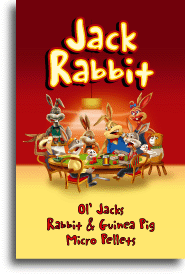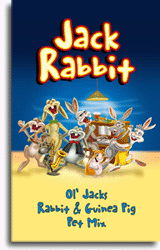


FOOD - Nikki White
Basically they need a good mix (lucerne chaff, seeds and grains), rabbit pellets and fresh vegetables and fruit, and hay, daily.
In this country there are a number of commercial makers of mixes for cavies. These are Peter's, and Dux Rabbit & Guinea Pig Food (available at Woolworths or Coles), Golden Grain (Master Foods) (sometimes available at Big W) , and Jack Rabbit (available at some produce stores and occasionally at Big W).. They are intended for rabbits as well. There is also Lovitt's I(aka Dr. Harry;s) but I haven't seen it recently. Unlike the UK, this is as specialised as we get. These brands have added Vitamin C which cavies must have every day but rabbits need about as much as Custer needed more Indians. They come in 2kg packs so are suitable for those who have only a couple of cavies. Peter's packages meadow hay in 2kg packs under the title 'bedding hay' and this is useful as well for those with only a few cavies as they can sleep in it or eat it ad lib.



For those with more cavies than say six, the mixes available from stockfeed merchants may be more economical as they come in larger quantities. These are based on horse feeds, usually something like (in the A.C.T.) Barastoc Completo (contains molasses) or Pryde's Easy Result for Pleasure Horses. This is mixed with lucerne chaff, rabbit pellets, MitaVite Economix (an equine kibble) - I've always said our cavies may not get up at the National but they should do very well at the Melbourne Cup) - and, particularly in winter, cracked lupins and/or horse oats.
There are three brands of pellets available in bulk (i.e 20 or 25 kg bags) locally: Coprice, Jack Rabbit and VetaFarm while Peter's does a small 2kg pack). Pellets were originally developed for commercial meat rabbits and are designed to fatten the rabbit up quickly for the abattoir. Thus they should not be fed in excess unless the cavy is under-sized. Many cavies do not like the pellets anyway. One breeder/judge I know calls them 'expensive bedding'.

Top left: Horse mix (Vitality Plus). Bottom left: Rabbit pellets. Top right: Lucerne chaff. Bottom right: Economix
Fruit and vegetables are more important. Like humans and apes and unlike other domestic animals, cavies cannot manufacture Vitamin C themselves. So they should have plenty of plants with Vitamin C in them. The coarse fibre of many plants helps to wear down their teeth which grow constantly and if not worn down can cause health problems.
Good sources of Vitamin C include parsley, carrots, broccoli, apples, beetroot, melon, tomatoes, mangoes, cabbage (but no yellow leaves), corn on the cob (good for wearing down teeth, too), green and red peppers, parsnips, pears, peas, beans, pumpkin, strawberries, turnips, spinach, swedes, Chinese vegetables, chicory, endive. They should be fresh, not wilted, and be washed. Not all cavies like all of these (mine give melon and tomatoes a miss and are none too keen on beetroot, quite like banana - a good source of potassium - and adore carrots, celery, apples, cucumber and parsley). Lettuce can be fed but as it hasn't much nutritional value I regard it as like having an iced lolly in summer. Keeps you cool and refreshed but little else. It does contain laudanum which is probably why the naughty rabbits in Beatrix Potter all fell asleep after scarfing all the farmer's lettuces and too much can cause diarrhoea. Incidentally, carrots and beetroot are not a brilliant idea the night before a show on light coloured cavies. Orange or pink chops are not a good look.
Poisonous plants to be avoided include rhubarb, radishes, potatoes, hemlock, belladonna, foxglove, anything grown from a bulb.
Some cavy care books rather sentimentally (in my view) state that cavies like to share their fruit or veggie treats and that a boar will give the best bits to his pregnant mate. This isn't so in my experience. They obviously haven't read the same books I have. It's every pig for him/herself. I've seen boars shove their sow mates out of the way and grab the best bits and I've seen sows dive under the boar's radar to snatch the boar's fruit from beneath his nose. Sows will get quite stroppy and squabble with each other over treats. So it is sometimes important to make sure each one is getting his/her fair share.
Some books recommend a salt lick to provide extra minerals. These are tied on the side of the cage and doubtless they are a good idea but none of my mob, with the exception of one or two rabbits, ever so much as touches them.
Another extra is the guinea pig treat, either in the form of a stick or something which looks like a muesli bar. They are imported so can be a bit dear for what they are, though Peter's makes a muesli stick. They come in different flavours. Their virtue is that they give cavies something to work their teeth on. Their disadvantage is that they are full of sugar from the honey that covers them to the sweet dried fruit in them. They should be given in moderation.
A third add-on is the gnawing toy. These are usually made of wood and shaped like a carrot or some other vegetable, and coloured accordingly. Some varieties are made of something which looks like pumice. They are more useful for rabbits but cavies can benefit though not all will use them. Again, they are to keep the cavies' teeth worn down.
In Canberra we tend to have 'cold climate cavies'. These, while certainly not underweight, are often smaller than cavies from the coastal regions of NSW. It's as if the cavy puts all its efforts into keeping warm in the colder months with little left over to grow big. Cavies from Wagga are similarly smaller. I tend to give mine more food in winter, especially mixes with molasses. I even bought a bucket of molasses to add to the feed one winter. I have also experimented with a mash made up of bran and pollard but didn't notice much difference. Bran is just a laxative, anyway, though pollard has some nutritional value.
The biggest pigs I have seen usually belong to breeders who live near the coast and not far from a market gardener or who have a tame greengrocer who passes on all his leaves or fruit and vegetables not quite up to standard for selling to humans but still fresh and good for cavies. I am not sure why this is so since bulk comes form dry food mostly. Those of us who have to rely on what we can get from Woolworths or Coles are limited in the quantities we can afford. But there is no doubt cavies flourish when fed lots of vegetables and fruit.
For further information, see the list of cavy books .